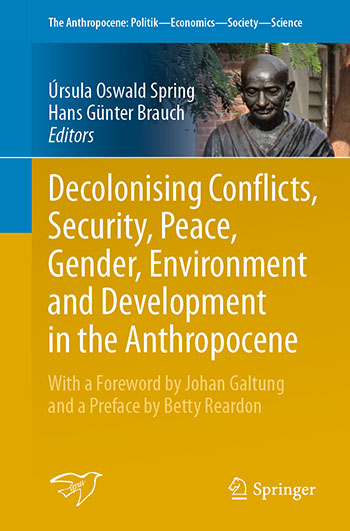| Publikationen von Mitgliedern des Vorstands der HGB-Stiftung | Publikationen zu Fragen von Frieden und Ökologie im Anthropozän |
Publikationen zu Fragen von Frieden und Ökologie |
||||||||
|
Zur Friedensökologie
Abstract ‘Peace ecology’ is a scientific approach that aims to build bridges between peace research and environmental studies. In 2000, Paul J. Crutzen introduced the Anthropocene as a new epoch of Earth’s history. Geologists still need to identify evidence in the sediments, e.g. from nuclear explosions and the testing of nuclear and hydrogen weapons in the atmosphere, that such a transition has actually occurred. Direct human interventions into the Earth System through the accumulation of greenhouse gases and carbon dioxide (CO2) in the atmosphere have caused multiple societal impacts, resulting in rapid increases in production, consumption, urbanisation, pollution, migration, crises and conflicts. Peace ecology in the Anthropocene era of Earth and human history can be conceptualised on the basis of five conceptual pillars: peace, security, equity, sustainability and gender. This chapter develops ‘peace ecology’ in the context of the Anthropocene in ten sections. After a detailed conceptual introduction (2.1), the second section (2.2) discusses five alternative starting points of the Anthropocene: the Agricultural or the Industrial Revolutions, the Columbian Exchange, the Nuclear era and the ‘Great Acceleration’, while the third section (2.3) offers a conceptual mapping of the Anthropocene and the fourth section (2.4) interprets the Anthropocene as a turning point, context and challenge for science and politics. For the new context of the Anthropocene section 2.5 offers a rethinking of peace and the evolution of peace research since the end of World War I, World War II and the Cold War in selected countries and the development of three international peace research organisations: IPRA, PSS(I) and ISA-PEACE. A reconceptualisation of peace in the Post-Cold War Era (1990-2020) and in the Anthropocene is also taking place. Section 5.6 reviews the evolution and rethinking of several ecology concepts (human, political, social) and (political) geo-ecological approaches during the Anthropocene. Section 2.7 reviews several bridge-building initiatives between peace research and ecology that were previously developed by scholars (e.g. Kenneth and Elise Boulding, Arthur H. Westing et al.) and were suggested during the conceptual debate on environmental and ecological security and in the empirical case studies by Günter Bächler (Switzerland) and Thomas Homer Dixon (Canada) on environmental degradation, scarcity and stress as causes and on conflictive outcomes. Since the end of the Cold War, from a policy perspective, debates have evolved on environmental peacemaking and post-conflict peacebuilding and on climate change, security and conflict linkages. While older bridge-building efforts stemming from peace research have addressed issues related to violence, more recent discourses emerging from environment and sustainability studies have addressed issues of sustainability transition and their impact on sustainable peace (Peck 1998) initiatives in the Anthropocene (2.7). Section 2.8 focuses on the suggested peace ecology approach and research programme as a holistic, enlightening and critical scientific project for the Anthropocene. For this it is necessary to overcome the fragmentation of scientific and political knowledge to incorporate holistic perspectives and transformative approaches that facilitate the move from knowledge to action. In Section 2.9 the author addresses the need to develop an ecological peace policy for the second phase of the Anthropocene (2020-2100) by developing strategies and policies to surmount the challenges in the Anthropocene. In Section 2.10 the author concludes by proposing a peace ecology research programme and an ecological peace policy in the Anthropocene (2.10). |
|
| Impressum | Datenschutz | Flyer |

